
Year in Review 2005–06: Part 3
January 2006
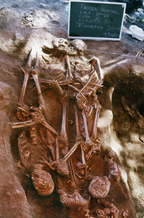
Centuries-old remains.
A team of researchers from UW–Madison and the Autonomous University of the Yucatan announce that while digging in a colonial era graveyard in one of the oldest European cities in Mexico, archaeologists found what they believe are the oldest remains of slaves brought from Africa to the New World. The remains date between the late 16th century and the mid-17th century, not long after Columbus first set foot in the Americas.
For the 20th consecutive year, UW–Madison takes the top national spot for alumni serving in the field as Peace Corps volunteers. “The current generation is graduating with a renewed sense of service and an international focus,” says Gregory Pepping, the UW–Madison Peace Corps campus representative.
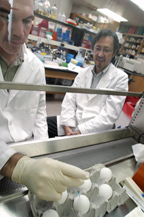
Harnessing flu viruses.
The puzzle of how flu viruses pass on genes from one generation to the next has been resolved, reports a UW influenza researcher in the journal Nature. The finding by Yoshihiro Kawaoka, a professor of virology, and his colleagues is important because it presents opportunities to design new antiviral drugs and harness flu viruses for speedier, more efficient vaccine production. The work is especially critical as the biomedical community and governments worldwide develop strategies to cope with the prospect of an avian influenza pandemic.
With topics ranging from nanotechnology to secondhand smoke and target audiences from at-risk children to cancer caregivers, a new round of Wisconsin Idea grants offer a fresh approach to serving state citizens. Just under $500,000 in grants ware allocated to eight campus projects through the 2006–08 Ira and Ineva Reilly Baldwin Wisconsin Idea Endowment. The Baldwins generously funded the endowment in 2002 to provide a steady stream of support for projects that enhance Wisconsin’s people, culture and way of life.
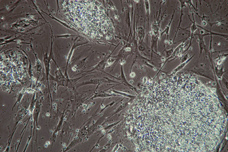
Research focus: stem cells.
Scientists working at the WiCell Research Institute, a private laboratory affiliated with UW–Madison, develop a precisely defined stem cell culture system free of animal cells and use it to derive two new human embryonic stem cell lines. The new work helps move stem cells a small step closer to clinical reality by completely ridding the culture medium in which they are grown of animal products that could harbor viruses or other deleterious agents. Some scientists worry that animal viruses and other problematic agents might be taken up in the human cells and infect human patients, should those cells be used for therapy.
February 2006
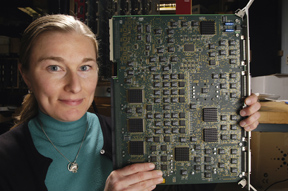
Super-fast image processor.
Nearing completion in the university’s physics department is the world’s fastest image processor, a camera of sorts that can analyze a billion proton collisions per second and, of those, gather digitized data sets. The ability to study the particles created by these collisions, scientists say, may well permit researchers to drill down to the true fundamental units of nature and study conditions that existed right after the Big Bang some 15 billion years ago when mass and energy were almost infinitely compressed.
Robert Golden, vice dean of the University of North Carolina (UNC) School of Medicine and former chair of the UNC Department of Psychiatry, in July will begin serving as the new dean of the UW School of Medicine and Public Health. Golden will be the ninth dean of the school, which will celebrate its centennial anniversary in academic year 2006–07.
A three-day Midwest Student Energy Conference brings together students and organizations from across the Midwest to discuss global warming and clean energy solutions. Workshops cover topics from environmental justice to the role of labor unions, and students learn about grassroots outreach, Internet advocacy, non-violent action and event planning.
An article in the Feb. 27 issue of BusinessWeek magazine names UW–Madison as tied for first place with Harvard for producing CEOs who head Standard & Poors 500 Index companies. The “Route to the Top” survey found that Wisconsin and Harvard each produced 14 such CEOs from their undergraduate alumni.
Confirming what many have long suspected, scientists at UW–Madison’s National Primate Research Center release findings that male monkeys of two different species get heavier when their mates are pregnant. The roughly 10 percent gain in male girth occurs in common marmosets and cotton-top tamarins, primates known for their monogamous lifestyles and devotion to good parenting. The knowledge that expecting primate fathers also experience biological changes can help scientists better understand what governs human fathering behavior, researchers say.
In addition to their studies, student musicians, dancers, actors and lighting designers make time to rehearse in preparation for “The Chancellor Presents the Performing Artists of the Future: A World Class Evening of Music, Drama and Dance,” held Feb. 25 at the Overture Center.
March 2006
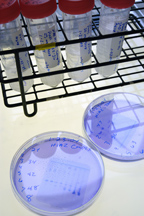
Leaders in science, technology.
The International Institute, the university’s portal to the world, marks its 10th anniversary. A 1996 joint initiative of the Division of International Studies and the College of Letters and Sciences, the institute has 16 member programs, eight of which are federally funded national resource centers. The institute covers every world region and has programs that lead the nation in international and area studies.
To kick off celebrations for the 50th anniversary of the Department of Hebrew and Semitic Studies, two internationally recognized scholars deliver lectures on campus. The anniversary, says Steve Nadler, director of the Mosse-Weinstein Center for Jewish Studies, “is a landmark occasion for the field of Hebrew and Semitic studies, of course, but also for UW–Madison.”
Linguists at UW–Madison launch the Wisconsin Englishes Project, which aims to explore and understand the unique patterns of regional vocabulary, pronunciations, idioms and ethnic influences on Wisconsin English.
Patrick Farrell, executive associate dean of the College of Engineering and a faculty member since 1982, is named provost and vice chancellor for academic affairs. As chief academic officer, the provost helps steer long-term academic direction through close collaboration with the deans of the university’s 12 schools and colleges. The provost also is responsible for faculty and staff development, diversity initiatives and enrollment management; is the point person for shared governance; and acts as chief executive officer of the university in the chancellor’s absence.
The Center for Global Health formally launches a certificate in global health, a collaborative offering from the schools of Medicine and Public Health, Nursing, Pharmacy and Veterinary Medicine and the Division of International Studies. Through a nine-credit program that includes global health field experience, the certificate prepares candidates to address health issues that transcend national boundaries, with an emphasis on health and disease in developing countries.
College of Engineering students take home first prize in the 2006 Society of Automotive Engineers “Clean Snowmobile Challenge” by adopting a comprehensive approach to the contest. The UW–Madison four-stroke Polaris takes first place in the emissions category, earning the Lotus Engineering and Horiba Instruments Award, and is competitive enough in all the other events to earn overall top honors.
UW–Madison leads the nation in the number of Sloan Foundation Fellowships in Science and Technology awarded in 2006. The foundation bestows the awards on young researchers in the fields of chemistry, computer science, economics, mathematics, molecular biology, neuroscience and physics.
The breadth of quality graduate programs at the university is evident in the latest academic rankings by U.S. News and World Report, which places 33 UW–Madison programs among the nation’s top 10. Among other successes, the School of Education ranks seventh in the nation with two of the school’s specialty programs, educational psychology and curriculum and instruction, rated No. 1; and engineering programs in chemical engineering and nuclear engineering rank fifth and third in the nation, respectively.